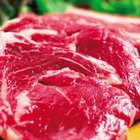
Once the date on the label passes, you begin to inspect your roast beef with a little more scrutiny, poking, sniffing and prodding the meat for signs of mysterious and all-too-ominous spoilage. You may want to dial down your trepidation; however, the “sell by” and “best by” dates on food, including commercially packaged roast beef and cold cuts from your grocer's deli, have more to do with taste than food safety. By and large, your own senses serve as the most reliable means of determining edibility and freshness.
Changing Colors
Most likely, your first inspection of questionable roast beef will be visual. Don't feel too alarmed if the meat isn't the exact same color as it was when you bought it; according to the USDA, color changes, a result of simple oxidation, are normal for meats. More often than not, your roast beef will fade or darken after a bit of time in the fridge, so visual inspection alone isn't enough to determine whether or not you should slap the roast beef on a sandwich.
Telling Textures and Suspect Smells
Although color isn't the end-all indicator of freshness, a noticeable translucent sheen typically indicates bad roast beef. In the same manner, if the beef feels slick or slimy to the touch, it's time to toss it. Past-due roast beef may also have a sticky or tacky texture. Finally, after inspecting and touching the cold cuts, give your roast beef a whiff; your nose is your most valuable tool in determining the usability of food. If the meat smells off or puts off a sulfurous, foul or otherwise rotting odor, it's no good.
The Truth About Rainbows
While a clear sheen is bad news, the oft-feared “rainbows” that appear on roast beef slices don't pose a threat. Unlike a slimy coating, these rainbows appear greenish, coppery or iridescent. While it certainly looks strange, this phenomenon occurs as a result of light hitting the meat and causing an effect known as "diffraction grating," the same process that gives your DVDs a rainbow-like appearance. Iridescent hues do not indicate spoilage or poor quality.
The Life Span of Lunch Meat
While the look, feel and especially the smell of roast beef clue you in to its freshness -- or lack thereof -- taking its typical shelf life into account helps you make the safest possible choice. For the longest-lasting roast beef, keep your meat refrigerated and sealed tightly in plastic wrap or aluminum foil. When refrigerated, roast beef from the deli counter or in an open package of commercial cold cuts typically lasts about three to five days, while unopened packaged beef lasts for about a week after its “use by” date. Sealed in an airtight container in the freezer, roast beef can last upward of two months, or indefinitely when frozen constantly at 0 degrees Fahrenheit.
Related Articles

How to Know if Beef Cubes Are Bad

How to Know if a Steak Is OK to Cook

How to Know if Marinated Steak Is Bad

Is a Roast Bad If It Turns Brown?

How to Know When Pork Roast Goes Bad

What Causes Raw Steaks to Lose Red ...

How Can I Tell If Lunch Meat Has Gone ...
How Long Should I Keep Steaks ...

What Happens if You Cook Steak a Day ...

How Long Can You Freeze a Roast?

Why Do Pork Chops Turn White?
How Long Can Steak Stay Good While ...

Should You Cook Raw Meat That's Gone ...

What Are the Green & Colored Tints in ...

How to Know if Bacon Has Gone Bad

How Do I Tell If Pork Has Turned Bad?

How to Choose Fresh Meat
What Happens if You Cook Steak a Day ...

What Does Spoiled Meat Smell Like When ...

Can You Eat Hamburger Meat That Is ...
References
- NPR: Don't Fear That Expired Food
- United States Department of Agriculture Food Safety and Inspection Service: The Color of Meat and Poultry
- United States Department of Agriculture Food Safety and Inspection Service: Beef from Farm to Table
- The Atlantic: What Causes Beef Rainbows?
- Still Tasty: Roast Beef Cold Cuts -- Sliced at Grocery Deli Counter
- Still Tasty: Roast Beef Cold Cuts/Lunch Meat, Commercially Packaged -- Opened
- Still Tasty: Roast Beef Cold Cuts/Lunch Meat, Commercially Packaged -- Unopened
Writer Bio
With a diverse professional background and a decade of experience as a freelance writer, Dan has contributed lifestyle content -- from fashion to travel to fitness and more -- to publishers including Chron, Fortune, Sony, GlobalPost, ModernMom, Moviefone, Salon.com, Techwalla and dozens of others.
Photo Credits
Jupiterimages/liquidlibrary/Getty Images